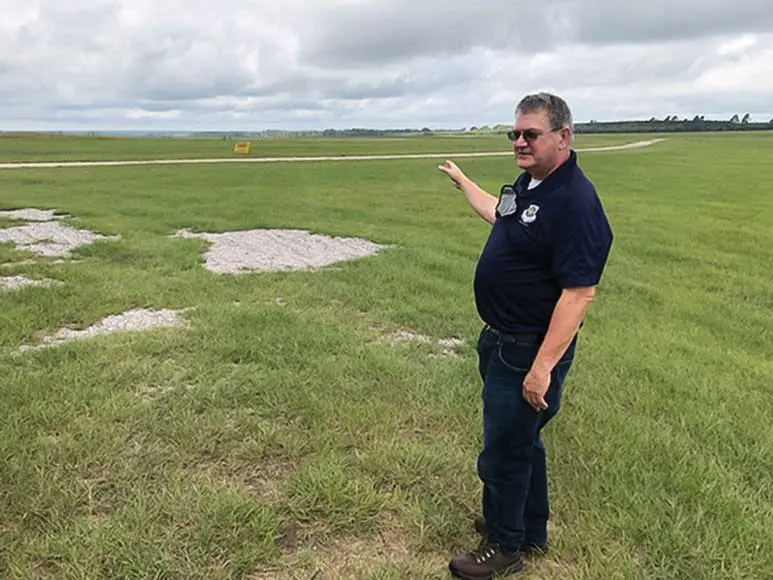Crash Landing Contributes to Improvements in Procedures
By MS. KATHY ALWARD, STAFF WRITER
Sometimes it takes a tragedy for positive changes to occur. Mr. Kevin Sluss, Acting Division Chief of Flight Safety for Air Mobility Command, was an Air Force C-130 Navigator in 1989. He provided testimony to this concept as he described his experience surviving a Class A mishap that prompted a procedure change in an emergency situation for airdrop crews.
As part of a C-130 crew from Dyess Air Force Base (AFB), TX, in 1989, Sluss flew to Pope AFB, NC, to conduct a week of airdrops as part of a five-ship formation. At this time, global positioning systems, night vision goggles, and self-contained navigation systems did not even exist. The crew included the aircraft commander, a former first assignment instructor pilot (IP) who had recently completed school and was new to flying in the left seat. At that time, some resources allowed the highly experienced IP to fly in the right seat. Sluss was the navigator and had been an instructor for about a year. The onboard flight engineer had experience and planned to separate later that year after completing his current enlistment. According to Sluss, the primary loadmaster, TSgt Charles Alfred, had considerable experience, and the secondary loadmaster had approximately 2 years of experience.
This mission was to drop three ships of personnel in support of an Army Emergency Deployment Readiness Exercise and drop two Sheridan armored reconnaissance vehicles that weighed more than 38,000 pounds. After the drop, the aircraft was to land at Mackall Army Airfield, NC, to load more paratroopers, and a crew chief flew on board to marshal the aircraft there.
According to Sluss, when loaded, the Sheridan fits precisely within the back of a C-130, leaving only small crawl spaces for transit to the back of the aircraft. At that time, Sluss said that many crews, including this one, believed that the deployment of the two extraction parachutes would create enough force to overcome the cargo locks and safely support the massive weight of the cargo to a predetermined drop zone.
The desired points of impact were marked with cerise-colored panels in the shape of block letters—C for equipment, A for personnel. From the air, Sluss said they could see the personnel block letter A, but they could not see the C panel because a shadow fell between the A and the C on the drop zone. They had no radio contact directly with the drop zone, so because they could not see the C for equipment, the lead ship stated that the absence of the pre-briefed mark was considered a no-drop by Sluss and his crew.
The only plan in place for a no-drop was to return to Pope by escaping to the north. When they started heading north, they discovered the error that the equipment C panel was visible, and they actually could see both block letters. According to Sluss, after the right seat pilot called the accompanying aircraft in the formation, they learned it had not yet arrived at the initial point about 20 miles north of the drop zone. The right seat pilot determined that they could accomplish a racetrack. This procedure was designed to be used when the entry into a reversal procedure is not practical and enables the aircraft to reduce altitude during the initial approach segment. Drop checklists were run after both crews agreed to turn to accomplish the racetrack.
According to Sluss, there was a problem with their aircraft because the left-hand locks remained engaged, preventing the release of the 38,000pound cargo, and the aircraft now had two extremely large parachutes deployed, causing drag, which necessitated a crash landing. Sluss called for the crash landing as the pilots tried to keep the aircraft out of the trees, alerting the crew chief to sit down and strap in on the crew bunk. Sluss said the landing was “harder than the worst assault landing you have ever experienced†due to the initial impact and ground run that were quite rough.
The five crew members in the front of the aircraft evacuated quickly before the pooling fuel near the aircraft caught on fire. The loadmasters were pulled from the aircraft with the help of an Army pilot and the Army medics that were supporting the exercise. Sadly, as the load broke free, the secondary loadmaster lost part of his right leg. TSgt Alfred was in critical condition and died from his injuries.
The crew believes he died attempting to crawl to the back of the aircraft to cut the extraction line with a knife to release the parachutes before the crash.
Sluss said that although this mishap was a tragedy in many ways, progress was made.
Post-event simulations discovered that a sustained 30-second pull on the “simul†handle would release the locks rather than short, repeated attempts. The sustained pull is now a standard emergency procedure. Also, they likely would have attempted the 160-degree turn to land on the Pope AFB runway had they known that the aircraft could have safely if turned at the proper airspeed, stated Sluss.


